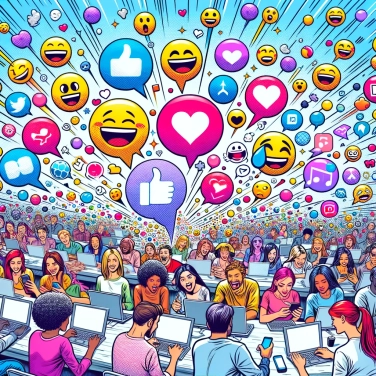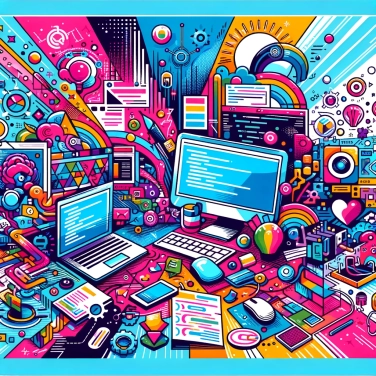Emojis have become a universal language on social networks because of their ability to communicate emotions and ideas quickly, clearly, and universally, transcending language barriers and facilitating communication on a global scale.

Emojis function as a visual language that we understand everywhere, regardless of culture or background. A smiling face, a thumbs up, or a red heart immediately resonate with everyone, without the need for translation. Why? Because these symbols are based on universal facial expressions and gestures that everyone spontaneously recognizes. Thus, when you communicate with someone on the other side of the world who doesn’t speak your language, emojis help bridge that gap and allow you to be understood directly. No need to be a polyglot, just a bit of emotion and it’s all good.
Emojis allow us to express emotions at a glance without having to write entire sentences: a small smiling or sad face is enough to instantly convey what we truly feel. A picture is worth a thousand words, and this is especially true with these tiny, highly expressive icons that effectively communicate our feelings or moods. Rather than explaining that we are angry, surprised, or laughing out loud, a well-chosen emoji provides clarity right away. One immediately understands the intention and mindset of the person using it, which easily avoids misunderstandings or questionable interpretations. It’s a quick, obvious, and precise way to transcribe an emotion or a spontaneous reaction.
Emojis owe their success mainly to their highly practical side: with just a few clicks, you can convey exactly what you feel. There's no need to master complex grammar or advanced vocabulary. Whether you're a kid or a grandfather, an expert or a beginner, everyone can easily use these little symbols from any phone or computer. A simple 😀, 😓, or ❤️ and boom, your thought is understood everywhere, effortlessly and even at high speed. It's direct, accessible, and straightforward: a big advantage compared to other more demanding forms of communication.
Social platforms like Facebook, Instagram, and Twitter (now X) have played a significant role in the democratization of emojis. By directly integrating emojis into their communication tools, they have made them accessible effortlessly to billions of users around the world. Facebook created the famous quick reactions ("Like," "Love," "Haha," etc.) based on emojis to make interactions easier and more immediate. On its part, Instagram encourages the intensive use of emojis in descriptions and comments to boost visibility. The same goes for instant messaging apps like WhatsApp or Messenger, with their series of emojis available at a simple click. Essentially, without us really realizing it, these platforms have embedded emojis into our daily lives, making their massive and universal use very natural.
Emojis are constantly adapting to closely reflect the cultural specifics of each individual. For example, you will find emojis representing typical dishes like sushi 🍣 or tacos 🌮, as well as traditional clothing. They also regularly update on matters of cultural identity or diversity, such as variations in skin color or the representation of diverse families. This flexibility in their evolution helps to maintain their popularity around the world. Every year, new emojis appear, others evolve, or are adapted to take into account new cultural trends and usages. The result: they always remain current, relevant, and close to our daily lives.
Originally, emojis were created in Japan in 1999 by Shigetaka Kurita to help communicate emotions quickly through electronic messages.
Every July 17th is celebrated as World Emoji Day, a date chosen because it is the one that appears on the screen of the calendar emoji 📅.
Every year, new emoji proposals are submitted to an international consortium called Unicode, which decides which emojis to adopt based on their cultural relevance and potential popularity.
In 2023, more than 3,600 emojis are available on digital platforms worldwide, offering a wide range of expressions representing objects, animals, activities, and emotions.
The creation of new emojis is under the purview of an organization called the Unicode Consortium. Each year, it approves or rejects proposals from various stakeholders or the general public, while ensuring inclusivity and cultural diversity.
Although emojis greatly facilitate the quick expression of emotions and enrich visual communication, they cannot fully replace traditional written language, which allows for the expression of complex, nuanced, and detailed ideas.
You can propose an emoji directly to the Unicode Consortium by filling out a detailed request on their official website. Your proposal should include strong cultural or social justifications to increase the chances of approval.
Indeed, some emojis are often misinterpreted or used outside of their original meaning. For example, the folded hands 🙏 sometimes represent gratitude, while other times they signify a prayer. Checking their original meaning can help avoid misunderstandings.
The majority of emojis have a generally comparable meaning, but some may vary depending on cultures and regions. It is advisable to check their local interpretation to avoid intercultural misunderstandings.

0% of respondents passed this quiz completely!
Question 1/4